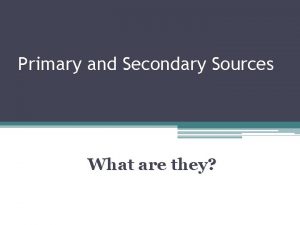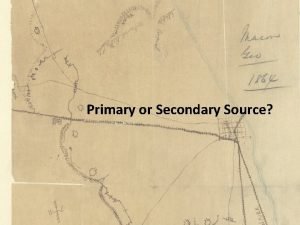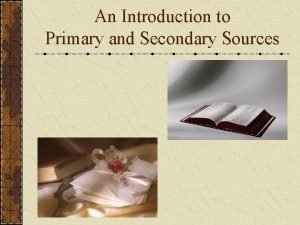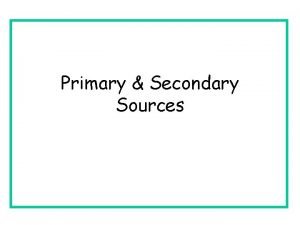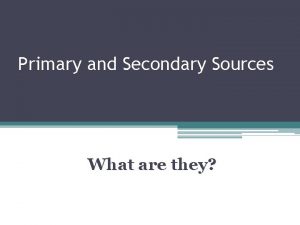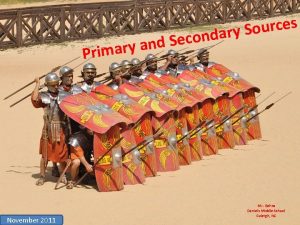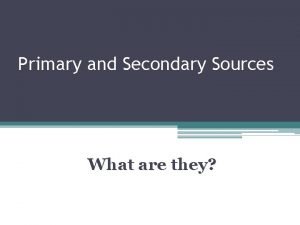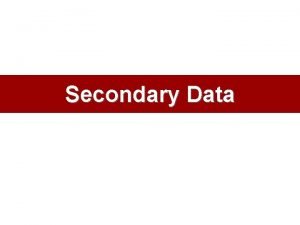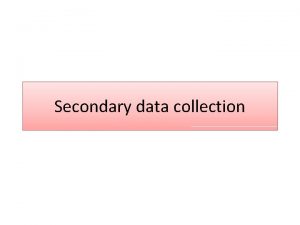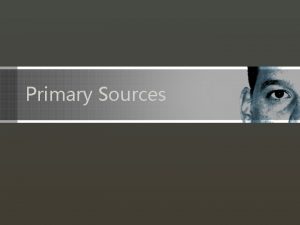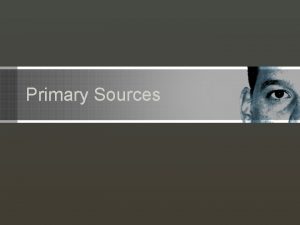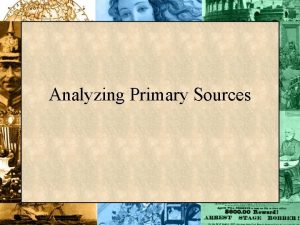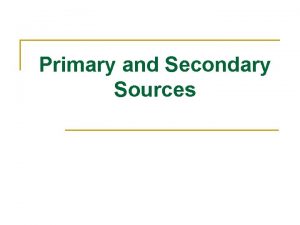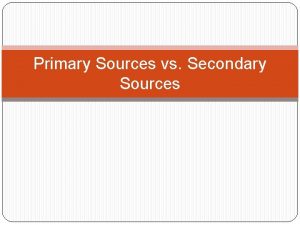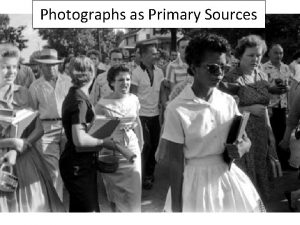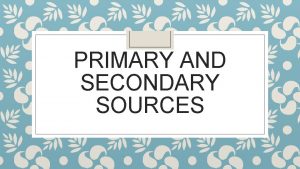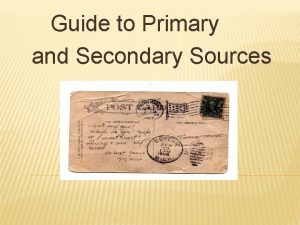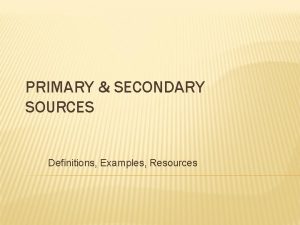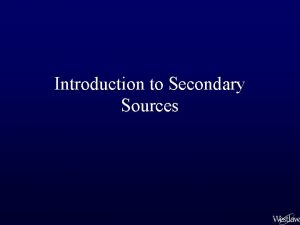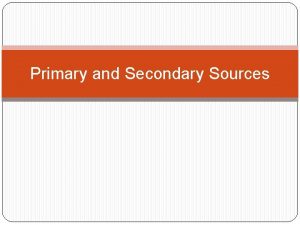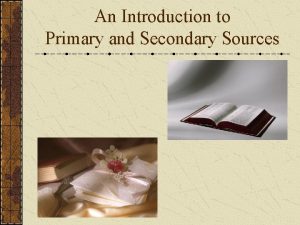An Introduction to Primary and Secondary Sources Primary































- Slides: 31

An Introduction to Primary and Secondary Sources

Primary Sources Be sure to have these notes in your primary sources column in your notebook.

What are primary sources? Original records from the past recorded by people who were: Involved in the event Witnessed the event, OR Knew the persons involved in the event

What are primary sources Primary sources are the original sources of information recorded at the time an event occurred. s First-hand accounts of events s Data collected for scientific studies s Historical documents

What are primary sources? They can also be objects (artifacts) or visual evidence. They give you an idea about what people alive at the time saw or thought about the event. Primary sources can also be written well after events. - memoirs - oral histories

Why should we use primary resources? To explain how major events are related to each other in time. To think critically and distinguish between fact and opinion. To recognize point of view in print and visual materials.

Why should we use primary resources? To develop your own conclusions and analyze how historical events affect your life. To recognize failures and successes in the past in order to make better decisions as a citizen. To understand who you are by examining your roots or placing yourself in that time period or situation.

What are primary sources? Keep in mind that a primary source reflects only one point of view and may contain a person’s bias (prejudice) toward an event. What can we do about that?

Finding Primary Resources Use the library catalog Ask your librarian Search article databases and limit to primary sources or peer-reviewed Search Google (remember to specify primary resources Use images from your text- must be cited

Examples of primary sources: Printed Publications Books, magazines, newspapers

Examples of primary sources: Personal Records Diaries, journals, records

Examples of primary sources: Visual Materials Paintings, drawings, sculpture

Examples of primary sources: Visual Materials photographs, film, maps

Examples of primary sources: Oral Histories Click on this button to hear an example of oral history ---- > Chronicles, memoirs, myths, legends passed down by word of mouth

Examples of primary sources: Songs and Poems

Examples of primary sources: Artifacts Tools, ornaments, objects

Secondary Sources Be sure to have these notes in your secondary sources column in your notebook.

What are secondary sources? Secondary sources are made at a later time. They include written information by historians or others AFTER an event has taken place. Secondary sources of information are derived from primary sources Summaries of primary sources Analyses or interpretations of primary sources

What are secondary sources? Although they can be useful and reliable, they cannot reflect what people who lived at the time thought or felt about the event. But they can represent a more fair account of the event because they can include more than one point of view, or may include information that was unavailable at the time of the event.

Why use secondary sources? To get expert opinions in order to evaluate what really happened. To gain insight by examining the same event from different perspectives. To form your own opinion. To save time by reading information collected from a number of different sources.

Finding Secondary Sources Use the library catalog Ask a librarian Use article databases Search Google Read articles, textbooks, and biographies Check newspapers and magazine Watch documentaries

Examples of secondary sources: Textbooks, biographies, histories, newspaper report by someone who was not present

Examples of secondary sources: Charts, graphs, or images created AFTER the time period.

Evaluating a source Not every sources is reliable Some have bias Some are not factual Some are misinterpreted What are some unreliable sources that you know of? How do you know they are unreliable? What are some warning signs of an unreliable source?

Evaluating a source What are some reliable sources? How can you identify a reliable source? What signs should you look for? Where is the best place to locate reliable sources? What sort of sources do we need to use for historical research? Can biased sources ever be helpful?

Both Primary and Secondary sources may have a slant or bias You need to look at both primary and secondary sources critically to see if they are promoting a particular point of view or showing both sides of an issue. Bias can also show up by what is left out, as much as by what is left in.

Primary Source Bias Example: John Adams Personal Papers In his personal letters to Thomas Jefferson, John Adams viewed his role in the creation of the Declaration of Independence as central. But, Thomas Jefferson, as the primary author of the document, gets much of the credit in history textbooks.

Secondary Source Bias Example: History Textbooks A history textbook is a secondary source. Because there is so much history to cover, much of what is discussed shows the positives and not the negatives. The author of Lies My Teacher Told Me provides less flattering, although factual, portraits of some individuals who have played significant roles in the history of the United States.

Think about a source Ask these basic questions about every source, no matter how obvious the answer might seem. Who wrote this? What does it say? When was it written? Where was it written? Why was it written?

Summing It Up It is important to determine the type of information you are looking at. Primary sources are original sources of information Secondary sources summarize, analyze, or critique primary sources Both primary and secondary sources can be good sources of information, but you need to critically evaluate them.

The End You should have plenty of notes to study for the test next week You should understand the differences between the two types of resources You should be able to give examples of each kind of resource You should be able to identify if a resource is either primary or secondary.
 Tertiary sources
Tertiary sources What is a primary source
What is a primary source Secondary light sources
Secondary light sources Ecological succession
Ecological succession The passing
The passing Print and web sources
Print and web sources Importance of water sources
Importance of water sources Syndicated panel surveys measure
Syndicated panel surveys measure Secondary sources
Secondary sources Is an illustration a primary or secondary source
Is an illustration a primary or secondary source Coca-cola secondary brand associations
Coca-cola secondary brand associations Ornaments primary or secondary source
Ornaments primary or secondary source Data collection secondary data sources
Data collection secondary data sources Secondary sources
Secondary sources Secondary sources
Secondary sources Disadvantages of secondary sources
Disadvantages of secondary sources Secondary sources
Secondary sources Primary evidence vs secondary evidence
Primary evidence vs secondary evidence Secondary sources
Secondary sources Secondary sources of history
Secondary sources of history Primary vs secondary source
Primary vs secondary source Secondary brand associations examples
Secondary brand associations examples Syndicated sources of secondary data
Syndicated sources of secondary data Example of secondary data
Example of secondary data Bluebook secondary sources
Bluebook secondary sources Secondary sources of brand knowledge
Secondary sources of brand knowledge Sparta primary sources
Sparta primary sources Lindisfarne raid primary sources
Lindisfarne raid primary sources Scientific revolution primary sources
Scientific revolution primary sources Uncw jstor
Uncw jstor Buffalo soldiers primary sources
Buffalo soldiers primary sources Is biography a primary source
Is biography a primary source

